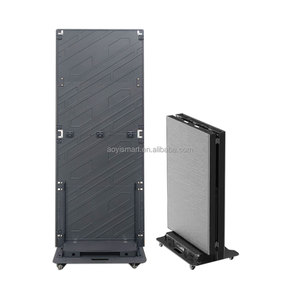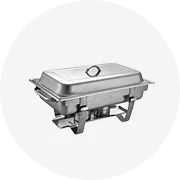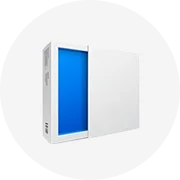Types of Display Dock
A display dock is a hardware device that enables users to connect portable electronic devices—such as smartphones, tablets, or laptops—to larger displays like monitors or TVs. Beyond video output, these docks often provide additional connectivity options including USB ports, Ethernet, audio jacks, and more. As mobile devices continue to evolve into powerful computing tools, display docks play a crucial role in bridging the gap between mobility and desktop-like productivity. Below are the primary types of display docks available today, each designed to meet specific user needs and performance requirements.
USB-C display dock
With its compact design and multi-functionality, the USB-C display dock has become one of the most versatile docking solutions on the market. It utilizes the universal USB-C port found on many modern laptops, smartphones, and tablets to deliver Power Delivery, high-resolution video output (up to 8K), and fast data transfer speeds simultaneously.
Advantages
- Supports simultaneous charging, video output, and data transfer
- Compact and lightweight design
- Backward compatible with older USB standards
- Widely supported across modern devices
Limitations
- Limited maximum bandwidth compared to Thunderbolt
- Not all USB-C docks support full 4K/60Hz or dual-display setups
Best for: Office workers, travelers, students, and general-purpose use
Thunderbolt display dock
The Thunderbolt display dock offers the highest level of performance among display docks by combining ultra-fast data transfer speeds (up to 40Gbps with Thunderbolt 4), support for multiple 8K displays, and robust peripheral connectivity. These docks are ideal for professionals who demand top-tier performance from their setup.
Advantages
- Extremely fast data transfer (up to 40Gbps)
- Supports multiple high-resolution displays
- Daisy-chaining capabilities for connecting multiple Thunderbolt devices
- Excellent compatibility with high-end workstations
Limitations
- Higher cost compared to other dock types
- Requires Thunderbolt-compatible devices
Best for: Video editors, graphic designers, engineers, and gaming enthusiasts
HDMI display dock
An HDMI display dock provides a straightforward solution for connecting portable devices to external displays via HDMI ports. These docks typically include an HDMI port along with additional USB-A ports, audio jacks, and sometimes even Ethernet connectivity, making them ideal for entertainment and basic productivity setups.
Advantages
- Simple plug-and-play functionality
- Great for connecting to TVs and home theater systems
- Supports up to 4K resolution
- Cost-effective option for casual users
Limitations
- Limited data transfer capabilities
- No power delivery over HDMI alone
- Fewer peripheral connection options compared to USB-C or Thunderbolt
Best for: Home entertainment, casual browsing, and classroom presentations
Wireless display dock
Wireless display docks eliminate the need for physical cables by using technologies like Miracast, Wi-Fi Direct, or proprietary protocols to mirror or extend device screens onto larger displays. These docks offer unmatched convenience, especially in collaborative environments where frequent device switching is required.
Advantages
- Completely cable-free experience
- Easy to switch between multiple devices
- Ideal for meeting rooms and classrooms
- Minimal desk clutter
Limitations
- Potential latency issues during video playback or gaming
- Dependent on stable wireless network connections
- May require specific software or drivers
Best for: Conference rooms, lecture halls, smart homes, and collaborative workspaces
| Type | Video Output | Data Transfer Speed | Power Delivery | Best For |
|---|---|---|---|---|
| USB-C Display Dock | Up to 8K | Up to 10Gbps | Yes (up to 100W) | Office workers, students, everyday users |
| Thunderbolt Display Dock | Up to dual 8K or quad 4K | Up to 40Gbps | Yes (up to 100W+) | Creative professionals, gamers, workstation users |
| HDMI Display Dock | Up to 4K | Limited (via USB-A only) | No | Home entertainment, casual use |
| Wireless Display Dock | Up to 4K (varies) | Limited (dependent on Wi-Fi) | No | Meetings, presentations, collaboration |
Expert Tip: When choosing a display dock, always check your device's specifications to ensure compatibility with the dock’s interface (e.g., Thunderbolt 4 or USB-C). Also, consider future-proofing by opting for a dock that supports higher resolutions and faster data speeds than you currently need.
Specifications and Maintenance of Display Docks
Understanding Key Specifications
Display docks serve as essential peripherals for enhancing productivity and connectivity in both home and office environments. Choosing the right display dock involves understanding its key specifications that determine performance, compatibility, and functionality:
Port Variety and Connectivity Options
A high-quality display dock should offer a comprehensive selection of ports to accommodate various devices and peripherals. Common port types include:
- HDMI Ports: Ideal for connecting external monitors or projectors with support for high-definition audio and video output.
- USB-C/Thunderbolt Ports: These provide versatile connectivity for data transfer, power delivery, and video output through a single cable.
- USB-A Ports: Useful for connecting traditional peripherals like keyboards, mice, and flash drives.
- DisplayPort (DP): Offers higher bandwidth than HDMI, making it ideal for multi-monitor setups and ultra-high-resolution displays.
- Ethernet Port: Ensures a stable wired internet connection, which is crucial for professionals requiring low-latency networking.
- Audio Jacks: Allow users to connect headphones or speakers directly to the dock without needing separate adapters.
The combination of these ports enables users to create an efficient workstation setup with minimal clutter and maximum flexibility.
Video Resolution Support
One of the most important features of a display dock is its ability to support high-resolution displays. Most modern docks are capable of delivering either 4K or 8K resolution outputs:
- 4K Resolution: Supports Ultra HD content at 3840 x 2160 pixels, offering four times the clarity of Full HD. Ideal for creative professionals, gamers, and general multimedia use.
- 8K Resolution: Provides exceptional detail at 7680 x 4320 pixels, suitable for advanced editing workflows, digital signage, and immersive gaming experiences.
When selecting a display dock, ensure it supports the native resolution of your monitor(s) to avoid downscaling or loss of visual quality.
Power Delivery Capabilities
Power delivery (PD) is a critical feature for laptops and other portable devices that rely on USB-C for charging. A good display dock can deliver up to 100 watts of power, allowing you to charge your device while using connected peripherals:
- 100W Power Delivery: Sufficient to fully charge most laptops and even some ultrabooks while maintaining full docking functionality.
- Lower Power Output (e.g., 15W): Suitable only for lightweight tasks and basic peripheral connections, often found in budget-friendly docks.
Docks with fast-charging capabilities can significantly reduce downtime and improve workflow efficiency by keeping your device powered throughout the day.
Data Transfer Speeds
Data transfer speed determines how quickly files, media, and other information can be moved between your computer and connected storage devices. Modern display docks typically offer speeds ranging from 10 Gbps to 40 Gbps:
- 40 Gbps (Thunderbolt 4/USB4): The fastest available option, ideal for transferring large video files, backing up data, or running high-performance external SSDs.
- 20-10 Gbps (USB 3.2 Gen 2): Suitable for everyday computing tasks, though may bottleneck performance with very large files or multiple high-speed devices.
Faster data transfer speeds not only enhance productivity but also future-proof your setup for evolving technology demands.
| Specification | Importance | Selection Tips |
|---|---|---|
| Number of Video Outputs | High | Choose based on your multi-monitor needs; look for docks supporting MST (Multi-Stream Transport) for triple+ display setups |
| Backward Compatibility | Medium | Select docks that work seamlessly with older devices and standards like USB 2.0 or VGA (with adapters) |
| Cable Length & Type | Medium | Ensure the dock has a sufficient cable length and preferred connector type (e.g., USB-C to USB-C) |
| Thermal Management | High | Look for docks with built-in heat dissipation features to prevent overheating during prolonged usage |
Essential Maintenance Practices
To keep your display dock performing optimally and extend its lifespan, regular maintenance is necessary. Here are detailed best practices:
Important: Always disconnect the display dock before cleaning or inspecting internal components. Using the dock while it's damaged or improperly maintained can lead to reduced performance, data loss, or even permanent hardware failure.
How to Choose a Display Dock
Selecting the right display dock is essential for maximizing productivity and ensuring seamless connectivity in both professional and personal environments. A well-chosen display dock can significantly enhance your workflow by allowing multiple monitors, peripherals, and charging capabilities through a single connection point.
Compatibility with Devices
The first and most critical consideration when choosing a display dock is compatibility. Ensure that the dock you choose works seamlessly with your primary device—be it a laptop, desktop, or hybrid tablet system.
- Check for compatibility with your operating system (Windows, macOS, Linux, Chrome OS)
- Verify that the dock supports your device’s connector type (USB-C, Thunderbolt, USB-A, etc.)
- Confirm whether your device supports DisplayPort Alt Mode if using a USB-C dock
Key tip: Always check the manufacturer's compatibility list before purchasing
Port Selection and Expansion
A display dock serves as a central hub for connecting various devices, so selecting one with the appropriate number and types of ports is crucial for future-proofing your setup.
- HDMI and DisplayPort outputs for connecting external monitors
- USB-A ports for legacy devices like keyboards, mice, and printers
- USB-C or Thunderbolt ports for high-speed data transfer and power delivery
- Ethernet port for wired internet connections
- Audio jacks, SD card readers, and other specialty ports
Consider: Number of current and anticipated peripheral devices
Display Capabilities and Resolution Support
Your display dock must support the resolution and refresh rate required by your monitor(s). This becomes especially important when working with dual or multi-monitor setups.
- Supports up to 4K UHD at 60Hz for most modern docks
- Dual-display capability via MST (Multi-Stream Transport)
- Higher-end docks may support 8K displays or multiple 4K monitors simultaneously
- Ensure compatibility with HDR standards if applicable
Note: Not all USB-C docks support full video bandwidth; verify specifications carefully
Physical Design and Portability
Depending on your usage scenario, the physical form factor of the display dock can be an important decision factor.
- Compact travel docks ideal for mobile professionals
- Larger stationary docks with more ports for office use
- VESA mountable options for clean integration behind monitors
- Cable management features for tidier workspaces
Tip: Consider ventilation and heat dissipation for continuous use
Budget Guidance: While entry-level docks are available under $100, investing in a higher-quality dock from reputable brands like Dell, Lenovo, or CalDigit can prevent connectivity issues, provide better build quality, and ensure longer-term reliability. Look for models with warranties and good customer support.
| Use Case | Recommended Features | Minimum Port Requirements | Estimated Price Range |
|---|---|---|---|
| Basic home office | Single monitor support, USB-A ports | 1x HDMI, 2x USB-A, 1x Power pass-through | $50–$100 |
| Professional workstation | Dual 4K support, Ethernet, USB-C | 2x DisplayPort/HDMI, 4x USB-A, 1x USB-C, Gigabit Ethernet | $150–$300 |
| Creative/developer setup | MST support, Thunderbolt, fast charging | Thunderbolt 4, 2x 4K displays, SD card reader, Ethernet | $300–$600 |
| Travel/mobile use | Compact size, USB-C only | 1x HDMI, 1x USB-A, 1x USB-C | $80–$150 |
Power Delivery and Charging: Many display docks also serve as charging hubs. Ensure the dock supports sufficient wattage (W) to charge your laptop effectively while powering connected devices. Most modern docks offer 60W–100W PD (Power Delivery), but some lightweight laptops may require less.
DIY Guide to Replace and Repair Display Docks
Modern smartphones and laptops often come with docking capabilities, especially portable display docks that allow users to extend their workspace or mirror content for presentations on larger screens. When these docks malfunction, it can disrupt productivity and workflow. However, many issues can be resolved without professional help by following this step-by-step guide.
Note: Always ensure your devices are powered off before beginning any repair or replacement work. This helps prevent electrical damage and ensures personal safety during the process.
Troubleshooting and Repair Steps
- Verify Power Supply Integrity
- Begin by confirming that the display dock is receiving power. Ensure the power cable is securely plugged into both the dock and a working wall outlet.
- Inspect the entire length of the power cable for signs of wear, fraying, or cuts. A damaged cable should be replaced immediately.
- If possible, test the power adapter using a known good outlet to rule out power source issues.
- Some docks have an LED indicator to show when they're properly powered. If no light appears, the issue might lie in the internal circuitry or power supply.
- Examine All Cables and Connections
- Check every physical connection between the dock and the display device, including HDMI, USB-C, DisplayPort, VGA, and any other relevant cables.
- Ensure all connections are tight and free from dust or debris that could interfere with signal transmission.
- Look closely at cable ends for bent pins, corrosion, or visible damage. These can cause intermittent or complete loss of signal.
- If available, swap out cables with known functional ones to identify faulty components quickly.
- Address Compatibility Issues
- Occasionally, display docks may stop functioning after a system update or when connected to new devices. Check the manufacturer’s official website for driver updates or firmware patches that address compatibility concerns.
- Review the dock's specifications to ensure it supports the resolution, refresh rate, and features required by your display and computing device.
- For USB-C docks, confirm that the correct Alternate Mode (Alt Mode) is supported for video output, such as DisplayPort Alt Mode or Thunderbolt compatibility.
- Test with Alternative Devices
- Connect the dock to a different laptop, tablet, or smartphone to determine whether the issue lies with the dock itself or the original device.
- This step helps isolate problems like faulty graphics chips, incompatible ports, or software conflicts on the primary device.
- If the dock works with another device, investigate potential settings or drivers on the original device that might be causing the problem.
- Perform a System Reset on the Dock
- If your display dock includes a reset button, press and hold it for about 10 seconds to restore factory defaults.
- If no reset button exists, disconnect all cables and accessories from the dock, wait at least 30 seconds, then reconnect them one by one while powering the dock back on.
- This simple reset often resolves minor glitches or handshake issues between the dock and connected devices.
- Contact Manufacturer Support
- If all troubleshooting steps fail to resolve the issue, reach out to the manufacturer’s customer support team with detailed information about the problem and the steps you've already taken.
- Be prepared to provide model numbers, serial numbers, and purchase dates if warranty service is applicable.
- Some manufacturers offer online diagnostic tools or remote support sessions to help identify hardware failures.
- Keep all receipts and documentation related to the purchase and attempted repairs in case you need to claim warranty coverage.
Pro Tip: Before replacing the dock entirely, try connecting it through a different port on your device or using a different combination of peripherals. Sometimes the issue is simply a specific port or peripheral conflict rather than a full dock failure.
When to Consider Replacement
In some cases, repairing the dock may not be cost-effective or technically feasible. Signs that it may be time to replace your display dock include:
- Repeated failure of multiple ports or functions
- Visible signs of internal component damage (e.g., bulging capacitors)
- Outdated connectivity standards that no longer meet your needs
- Lack of ongoing manufacturer support or driver updates
| Issue Type | Possible Cause | Recommended Fix | Estimated Time |
|---|---|---|---|
| No Power | Faulty power cable, blown fuse, or dead adapter | Replace power cable or adapter | 15–30 mins |
| No Video Output | Damaged video cable, incorrect input selection, or unsupported resolution | Try new cable, check input settings, adjust resolution | 10–20 mins |
| Intermittent Connection | Loose ports, worn-out connectors, or dust buildup | Clean ports, tighten connections, or replace affected cables | 10–15 mins |
| Compatibility Problems | Outdated firmware or unsupported devices | Update firmware, check device specs, contact support | Varies |
Replacement Advice: When purchasing a new display dock, consider future-proofing by choosing models with the latest connectivity options such as USB4, Thunderbolt 4, or multi-channel DisplayPort 1.4a. Also, look for docks with modular designs that allow for upgrades or part replacements over time.
Display Dock FAQ
While display docks offer convenient connectivity solutions, they are not universally compatible with all devices. Compatibility largely depends on the type of connection ports available on both the dock and the device. Common interfaces include:
- USB-C/Thunderbolt 3 or 4: Widely used for modern laptops and tablets.
- HDMI or DisplayPort: Standard for many desktop monitors and some laptops.
- Dock-specific connectors: Some proprietary docks use manufacturer-specific ports (e.g., Dell's WD series).
To ensure compatibility, users should verify that their device supports external display output through its port and that it can operate in "display mode" via that connection. Additionally, operating system support matters—some docks may work seamlessly with Windows but have limited functionality on macOS or Linux.
Yes, many modern display docks support multiple monitor setups, allowing for expanded workspace and enhanced productivity. However, this capability varies by model and specifications. Key considerations include:
- Graphics bandwidth: The host port (e.g., USB-C Thunderbolt 3/4 or HDMI 2.0+) determines how much data—including video signals—it can pass through to displays.
- Number of display outputs: Look for docks with multiple video ports like HDMI, DisplayPort, or even USB-C Alt Mode for connecting more than one screen.
- Maximum resolution and refresh rate: High-resolution setups (like dual 4K at 60Hz) require docks with sufficient bandwidth and compatible video standards.
For example, a Thunderbolt 4 dock typically supports up to two 4K displays or one 8K display, while a basic HDMI-only dock might only allow one external monitor. Always review the product specs carefully before purchasing if multi-display support is critical.
Many display docks include a feature known as "power passthrough," which allows them to charge your connected laptop or tablet while also providing access to peripherals and external displays. This functionality depends on several factors:
- Power delivery (PD) support: Look for docks that explicitly state Power Delivery support, typically rated in watts (e.g., 60W, 100W). Higher wattage docks can power larger laptops, including high-performance models.
- Cable and port requirements: To enable charging, you must use a compatible cable (usually USB-C to USB-C) and connect the dock’s power adapter properly.
- Device compatibility: Not all laptops support charging over USB-C or Thunderbolt—even if they have those ports—so double-check your device’s capabilities.
If charging is an essential requirement, prioritize docks with clearly advertised PD ratings and check reviews to confirm real-world performance. Avoid generic docks that don’t specify their charging capabilities.

































































